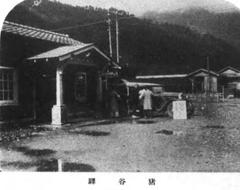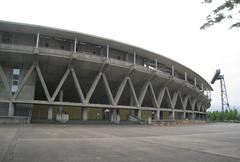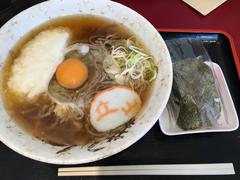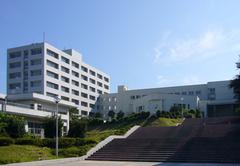
Toyama Bridge Visiting Guide: History, Significance, Tickets, and Tips for Toyama, Japan
Date: 04/07/2025
Introduction
Toyama Prefecture is home to two iconic bridges: the historic Toyama Bridge, a centerpiece of Toyama City’s cultural landscape, and the striking Shinminato Ohashi Bridge, a marvel of modern engineering. Together, these bridges exemplify Toyama’s harmonious blend of tradition, innovation, and scenic beauty. This guide offers a comprehensive look at their historical and cultural significance, architectural features, practical visitor information, travel tips, and nearby attractions. Whether you are interested in remarkable infrastructure, rich history, or immersive local experiences, Toyama’s bridges are gateways to the prefecture’s unique charm.
For official visitor information, including the latest on hours, tickets, and events, consult Visit Toyama Japan and Hietsuno Japan.
Table of Contents
- Introduction
- Historical Background & Architectural Features
- Visitor Information
- Seasonal Highlights & Travel Tips
- Nearby Attractions
- Safety, Etiquette, & Practical Advice
- Frequently Asked Questions (FAQ)
- Conclusion
- References
Historical Background & Architectural Features
Toyama Bridge: Tradition and Community
Origins & Historical Significance
Located in the heart of Toyama City, Toyama Bridge historically connected the castle district with the port of Iwase, supporting local industries such as medicine and glassmaking during the Edo period (Visit Toyama Japan, Sugoii Japan). Over centuries, the bridge developed into a symbol of community resilience and urban growth.
Artistic and Cultural Value
Toyama Bridge is celebrated for its glass art installations—public displays that highlight Toyama’s reputation as Japan’s “Glass City” (Japan Starts Here). The bridge’s proximity to the Toyama Glass Art Museum and the scenic Matsukawa Riverbank enhances its role as a living gallery for traditional and contemporary crafts.
Social Hub & Sustainable Urbanism
As a focal point for community gatherings, the bridge is integral to events like the hanami (cherry blossom viewing), the Owara Kaze no Bon Festival, and evening river strolls. It also plays a part in Toyama’s award-winning “compact city” initiative, promoting eco-friendly transportation and age-inclusive public spaces (ADS, ISHES).
Shinminato Ohashi Bridge: Engineering Marvel
Design & Construction
Completed in 2012, the Shinminato Ohashi Bridge (新湊大橋) is the largest cable-stayed bridge on the Sea of Japan coast, connecting the east and west sides of Toyama New Port (Hietsuno Japan). It stands out for its dual-level structure: the upper deck accommodates vehicles, while the lower “Ainokaze Promenade” is reserved for pedestrians and cyclists.
Architectural Features
- Length: 3.6 km (main span: 600 m)
- Height: Towers reach 127 m; roadway rises 47 m above sea level
- Structure: 72 diagonal cables, wind- and earthquake-resistant
- Aesthetics: Sleek design harmonizes with Toyama Bay and the Tateyama Mountain Range, offering panoramic vistas (Visit Toyama Japan).
Innovations & Sustainability
The bridge employs state-of-the-art materials, energy-efficient lighting, and environmentally considerate construction, ensuring minimal ecological impact while highlighting Toyama’s forward-thinking ethos (Japan Travel Navitime).
Visitor Information
Visiting Hours & Tickets
- Toyama Bridge: Open 24/7. No entrance fee.
- Shinminato Ohashi Bridge (Ainokaze Promenade): Open year-round, 24 hours. Free pedestrian access. Vehicle tolls apply for cars and buses.
- Closures: The promenade may temporarily close during severe weather (wind speeds exceeding 25 m/s) or for maintenance (Hietsuno Japan).
Access & Transportation
- Toyama Bridge:
- From Toyama Station: 15–20 min walk, short bus ride, or cycling along river paths.
- Signage: Clear directions in Japanese and English.
- Shinminato Ohashi Bridge:
- By Train: Hokuriku Shinkansen to Toyama Station, then local train/bus to Shinminato Station or direct bus to the port.
- By Car: Ample parking at both ends, elevator access to promenade.
- By Bus: Frequent local buses from city center.
- By Bicycle: Cycling paths connect to the bridge (bicycles not permitted on promenade, parking available).
Accessibility
Both bridges are designed for universal access:
- Wheelchair-friendly ramps and elevators
- Wide, smooth walkways
- Barrier-free access for strollers and those with mobility challenges
- Multilingual signage (Japanese, English; some Chinese/Korean at Shinminato Ohashi) (Japan Guide)
Guided Tours & Events
- Toyama Bridge: Local river cruises and walking tours often include historical commentary.
- Shinminato Ohashi Bridge: Occasional guided tours, illumination events, and seasonal festivals. Check Visit Toyama Japan for schedules.
Seasonal Highlights & Travel Tips
Best Times to Visit
- Spring (March–May): Cherry blossoms along Matsukawa River and Kansui Park. Average highs: 10–20°C (Time Travella).
- Summer (June–August): Lush greenery, evening festivals, and river reflections. Highs up to 32°C.
- Autumn (September–November): Brilliant foliage and clear mountain views. Highs: 18°C (September), 10°C (November).
- Winter (December–February): Snowy landscapes, crisp air, occasional illuminations. Lows to -6°C.
Festivals & Events
- Hanami (April): Cherry blossom viewing on Matsukawa Riverbanks, best seen from Toyama Bridge (Trip.com).
- Owara Kaze no Bon (September): Traditional dance festival with processions near Toyama Bridge (Overyourplace).
- Autumn Foliage: Late October–early November, spectacular colors along both bridges.
- Winter Illuminations: Occasional light displays on and around Toyama Bridge.
Photography & Sightseeing Tips
- Best Photo Spots: Bridge centers for panoramic mountain and river views; riverbanks for sunrise/sunset shots.
- Golden Hour: Early morning and late afternoon provide the optimal light, especially with the Tateyama Range as a backdrop.
- Seasonal Contrasts: Capture cherry blossoms, autumn leaves, or snow scenes for unique perspectives.
Nearby Attractions
- Kansui Park: Parklands ideal for picnics and seasonal flower viewing.
- Toyama Glass Art Museum: Contemporary and traditional glass art exhibitions.
- Historic Iwase District: Traditional port town with preserved architecture.
- Matsukawa River Cruise: Scenic boat rides with historical commentary.
- Kaiwomaru Park (near Shinminato Ohashi): Historic sailing ship, waterfront walks, and seafood dining.
- Toyama Castle Park: Historic site and museum in city center.
Safety, Etiquette, & Practical Advice
- Pedestrian Etiquette: Keep left, share walkways with cyclists, and respect other visitors.
- Weather Precautions: May is driest; December is rainiest. Bring appropriate attire and check forecasts (Time Travella).
- Accessibility: Both bridges are wheelchair and stroller-friendly.
- Amenities: Public restrooms, benches, vending machines near entrances; cafes and convenience stores nearby.
- Pets: Leashed pets welcome on promenades; owners must clean up after them.
- Emergency: Toyama Prefectural Central Hospital is nearby; call 110 (police) or 119 (fire/ambulance) for emergencies.
- Wi-Fi: Free Wi-Fi available at Shinminato Ohashi parking and elevator areas.
Frequently Asked Questions (FAQ)
Q: What are the visiting hours for Toyama Bridge and Shinminato Ohashi Bridge?
A: Both are open 24 hours; Shinminato Ohashi’s promenade may close during severe weather.
Q: Do I need a ticket to access either bridge?
A: No ticket is required for pedestrian access. Vehicle tolls apply to Shinminato Ohashi upper road.
Q: Are the bridges wheelchair accessible?
A: Yes, both bridges provide barrier-free access with ramps and elevators.
Q: Can I bring a bicycle on the bridges?
A: Bicycles are allowed up to the entrance of the Shinminato Ohashi promenade (parking provided), but not on the promenade itself.
Q: Are there guided tours?
A: Yes, river cruises and seasonal walking tours are available. Check official tourism sites for schedules.
Q: What are the best seasons to visit?
A: Spring (cherry blossoms) and autumn (foliage) are most scenic, but both bridges offer year-round appeal.
Conclusion
Toyama Bridge and Shinminato Ohashi Bridge are more than mere crossings—they are living embodiments of Toyama’s enduring heritage and innovative spirit. From vibrant festivals and glass art displays to panoramic mountain views and cutting-edge engineering, these landmarks invite visitors to experience the prefecture’s culture, history, and natural beauty in memorable ways. Plan your visit around seasonal highlights, explore nearby historical sites, and take advantage of the accessible, visitor-friendly amenities for a rich and rewarding journey.
For up-to-date information on visiting hours, events, and local guides, consult official tourism resources or download the Audiala app for exclusive travel content.
References
- Hietsuno Japan – Exploring Toyama’s Shinminato Ohashi Bridge: Visiting Hours, Tickets, and Attractions, 2024
- Visit Toyama Japan – Places to Go, 2024
- Sugoii Japan – Toyama Bridge Cultural and Social Significance, 2024
- Japan Starts Here – Toyama Travel Guide, 2024
- Unseen Japan – Toyama New Travel Destination, 2024
- Japan Travel Navitime – Shin-Minato Bridge Visiting Hours, Tickets, and Toyama Historical Sites, 2024
- Japan Travel – Toyama and Osaka Selected for the 2025 New York Times 52 Places to Go, 2024
- Overyourplace – Discover Toyama Culture, History, Festivals Guide, 2024
- ADS – Caring Place Toyama City Suits Its Citizens, 2023
- Time Travella – Toyama New Travel Destination, 2024
- Smartconf Toyama – About Toyama, 2024
- ISHES – Toyama’s Age-Friendly City Initiatives, 2023









